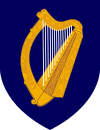
Back سياسة جمهورية أيرلندا Arabic Държавно устройство на Република Ирландия Bulgarian Politický systém Irska Czech Politisches System Irlands German Política de Irlanda Spanish Politique en Irlande (pays) French Poilitigs ann an Èireann Scots/Gaelic פוליטיקה של אירלנד HE Politika Irske Croatian Politica dell'Irlanda Italian
This article needs additional citations for verification. (September 2017) |
Politics of the Republic of Ireland | |
|---|---|
 | |
| Polity type | Unitary parliamentary democratic Republic |
| Constitution | Constitution of Ireland |
| Legislative branch | |
| Name | Oireachtas |
| Type | Bicameral |
| Meeting place | Leinster House |
| Upper house | |
| Name | Seanad Éireann |
| Presiding officer | Jerry Buttimer, Cathaoirleach |
| Appointer | Indirect Election |
| Lower house | |
| Name | Dáil Éireann |
| Presiding officer | Seán Ó Fearghaíl, Ceann Comhairle |
| Appointer | Election |
| Executive branch | |
| Head of State | |
| Title | President of Ireland |
| Currently | Michael D. Higgins |
| Appointer | Election |
| Head of Government | |
| Title | Taoiseach |
| Currently | Simon Harris |
| Appointer | President |
| Cabinet | |
| Name | Government of Ireland |
| Current cabinet | 34th government |
| Leader | Taoiseach |
| Deputy leader | Tánaiste |
| Appointer | Election by Oireachtas |
| Headquarters | Government Buildings |
| Ministries | 18 |
| Judicial branch | |
| Name | Judiciary |
| Supreme Court | |
| Chief judge | Donal O'Donnell |
| Seat | Four Courts, Dublin |
| Court of Appeal | |
| Chief judge | George Birmingham |
 |
|---|
Ireland is a parliamentary, representative democratic republic and a member state of the European Union. While the head of state is the popularly elected President of Ireland, it is a largely ceremonial position, with real political power being vested in the Taoiseach, who is nominated by the Dáil and is the head of the government.
Executive power is exercised by the government, which consists of no more than 15 cabinet ministers, inclusive of the Taoiseach and Tánaiste (the deputy head of government). Legislative power is vested in the Oireachtas, the bicameral national parliament, which consists of Dáil Éireann, Seanad Éireann and the President of Ireland. The judiciary is independent of the executive and the legislature. The head of the judiciary is the Chief Justice, who presides over the Supreme Court.
Ireland has a multi-party system. Fianna Fáil and Fine Gael, historically opposed and competing entities, which both occupy the traditional centre ground, trace their roots to the opposing sides of the Irish Civil War. All governments since 1932 have been led by one or the other party, with Fianna Fáil having had sufficient support at many elections to govern alone. Fluctuations in seat levels allowed changes in governments through different coalitions. From 1932 to 2011, the parties were stable in their support, with Fianna Fáil the largest at each election, Fine Gael the second largest, and on all but two occasions, the Labour Party the third party. The last three elections, however, have each had more volatile results. At the 2011 election, the largest parties in order were Fine Gael, Labour and Fianna Fáil;[1] at the 2016 election, the largest parties in order were Fine Gael, Fianna Fáil and Sinn Féin;[2] and at the 2020 election, the largest parties were Fianna Fáil first in seats (second in votes), Sinn Féin second in seats (first in votes), and then Fine Gael. The result was historically good for Sinn Féin.[3]
In June 2020, leader of Fianna Fáil, Micheál Martin, became the new Taoiseach (head of government). He formed a historic three-party coalition consisting of Fianna Fáil, Fine Gael and the Green Party. It was the first time in history that Fianna Fáil and Fine Gael were in the same government. The previous Taoiseach and leader of Fine Gael, Leo Varadkar, became the Tánaiste (deputy head of government). Martin led the country as Taoiseach until 17 December 2022, when he changed posts with Varadkar.[4]
The Economist Intelligence Unit rated Ireland a "full democracy" in 2022.[5] According to the V-Dem Democracy indices Ireland was the "7th most electoral democratic country" in the world in 2023.[6]
- ^ "Irish election: Enda Kenny claims opposition victory". BBC News. 26 February 2011.
- ^ "Irish election: Enda Kenny admits coalition will not return". BBC News. 28 February 2016.
- ^ "Irish general election: Sinn Féin celebrate historic result". BBC News. 11 February 2020.
- ^ "Micheál Martin becomes new Irish PM after historic coalition deal". BBC News. 27 June 2020.
- ^ "Democracy Index 2022: Frontline democracy and the battle for Ukraine" (PDF). Economist Intelligence Unit. 2023. Retrieved 9 February 2023.
- ^ "The V-Dem Dataset". V-Dem Institute. 2023. Retrieved 14 October 2023.
© MMXXIII Rich X Search. We shall prevail. All rights reserved. Rich X Search